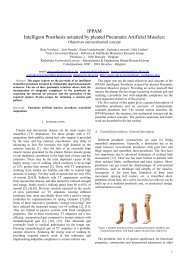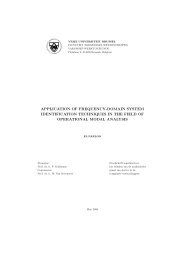VRIJE UNIVERSITEIT BRUSSEL Acoustics - the Dept. of ...
VRIJE UNIVERSITEIT BRUSSEL Acoustics - the Dept. of ...
VRIJE UNIVERSITEIT BRUSSEL Acoustics - the Dept. of ...
Create successful ePaper yourself
Turn your PDF publications into a flip-book with our unique Google optimized e-Paper software.
132 CHAPTER 8. NOISE ON THE WORK FLOORIf risks arising from <strong>the</strong> exposure to noise cannot be prevented in anyo<strong>the</strong>r way, appropriate, properly fitting individual hearing protection mustbe made available to <strong>the</strong> employees :When <strong>the</strong> lower action value is exceeded, hearing protection is madeavailable for <strong>the</strong> employees.When <strong>the</strong> upper action value is exceeded, hearing protection must beused.The individual hearing protection is selected in such a way that <strong>the</strong> risk onhearing impairment is eliminated or limited to a minimum (see fur<strong>the</strong>r). Theemployer is responsible for <strong>the</strong> application <strong>of</strong> <strong>the</strong> actions taken in this articleand takes care that <strong>the</strong> employees wear <strong>the</strong> hearing protection.The employees thatexecute anactivity witharisk duetonoise, where <strong>the</strong>exposure exceeds <strong>the</strong> lower action value, are subject to prior health examination(an examination <strong>of</strong> <strong>the</strong> hearing by means <strong>of</strong> a pre-emptive audiometricexamination, see fur<strong>the</strong>r). The periodicity <strong>of</strong> <strong>the</strong> health examination is determinedas follows :Yearly for employees who are exposed to a daily average exposureequal or larger to 87 dB(A) or a peak sound pressure <strong>of</strong> 140 dBC;Once every three years for employees who are exposed to an averagedaily exposure equal to or larger than 85 dB(A) or a peak soundpressure <strong>of</strong> 137 dBC;Once every five years for employees who are exposed to an averagedaily exposure equal or larger than 80 dB(A) or a peak sound pressure<strong>of</strong> 135 dBC.8.3 Risk <strong>of</strong> hearing damageOccupational deafness is permanent and irreversible hearing loss, caused byordinary working conditions. Certain types <strong>of</strong> occupational deafness maybe due to toxic products such as carbon monoxide (CO), carbon disulfide,benzene and lead. O<strong>the</strong>rs are due to brief exposure to intense sounds (e.g.gunshots or explosions), wherein a rupture occurs <strong>of</strong> <strong>the</strong> basilar membranein <strong>the</strong> cochlea <strong>of</strong> <strong>the</strong> eardrum, or, in <strong>the</strong> case <strong>of</strong> an explosion, <strong>the</strong> ossicles areaffected.
















